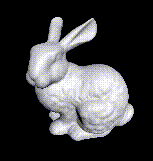

|
The Stanford 3D Scanning Repository |
In recent years, the number of range scanners and surface reconstruction algorithms has been growing rapidly. Many researchers, however, do not have access to scanning facilities or dense polygonal models. The purpose of this repository is to make some range data and detailed reconstructions available to the public. Currently, this repository only contains models that were scanned and reconstructed at the Stanford Computer Graphics Laboratory . In the future, we hope to include data sets and reconstructions from other sources.
The models in this repository were all scanned with a Cyberware 3030MS optical triangulation scanner. Each scan takes the form of a range image. Each range image is described in the local coordinate system of the scanner. In order to merge the range images, we must first align them, i.e., determine the transformation for each range image that will bring it into a canonical coordinate system. We have already determined the transformations for the range data in this repository; they are stored in ".conf" files that list each range image along with a translation and a quaternion rotation.
Some of the triangulation data comes directly from the Cyberware scanner, while the rest is the result of a method known as spacetime analysis . The surface reconstructions provided here are the product of the zippering and volumetric merging methods developed at Stanford. Implementations of both of these methods are currently available for download:
All of the shape data is stored in ply files. The ply format was developed at Stanford University, and the source code is available for download . For convenience, we have represented these files in their ASCII formats. Choosing ASCII makes it possible for someone unfamiliar with it to get a feel for the file format, and it avoids the problem of using the correct big-endian vs. little-endian byte orders. A future release of the ply format will take care of this latter issue. We also have a viewer called plyview that will read and display triangle meshes in the ply format. This viewer is in beta release and currently comes bundled with VripPack .
For questions and comments and to subscribe to the 3D Scanning Repository's email list, send mail to 3Dscanrep@graphics.stanford.edu .

Range data + zippered reconstruction:
Range data + zippered and vripped reconstructions:
Range data:
Range data:
Last update: September 8, 1996
curless@graphics.stanford.edu